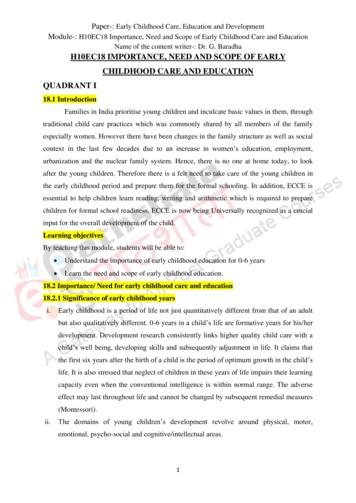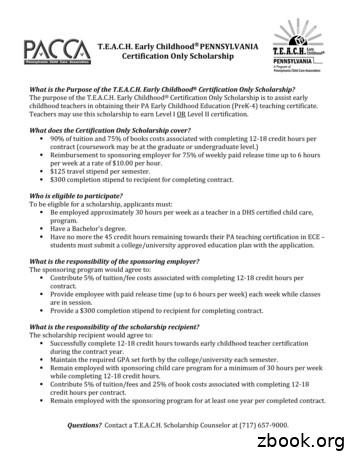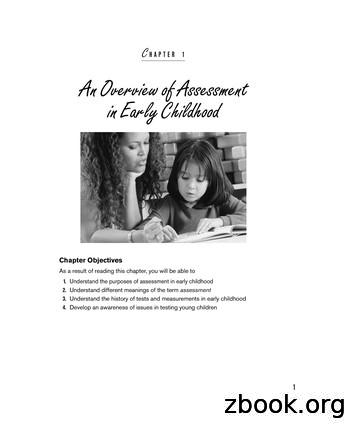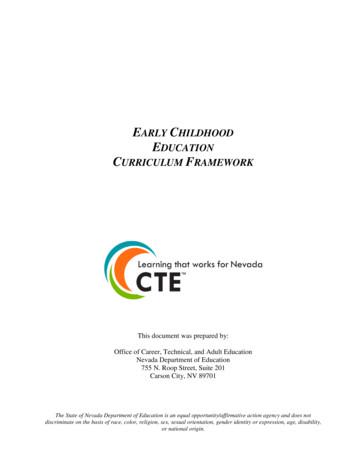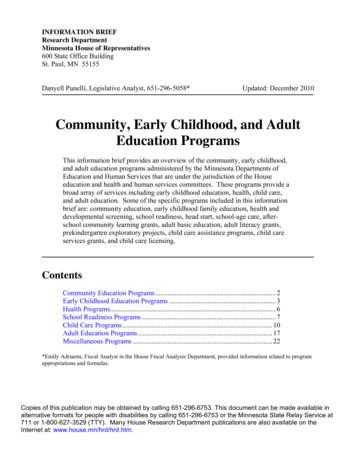Screen Time And Early Childhood Education A Review Of The Literature .
Running Head: SCREEN TIME AND EARLY CHILDHOOD EDUCATIONScreen Time and Early Childhood EducationA Review of the LiteratureChristopher FishpawTowson University1
SCREEN TIME AND EARLY CHILDHOOD EDUCATION2AbstractIn recent years, technology integration has been a main focus of early childhoodprograms. A major concern among educators is the amount of time students spend in front of thescreen and how screen time affects child development. Experts in the early childhood field havepublished literature about the importance of considering developmentally appropriate practice fortechnology integration. This literature review examines the issues around screen time and youngchildren. Technology use and its effects on physical and academic development of youngchildren are examined. Literature for early childhood educators and philosophical views on thedevelopmental appropriateness of technology integration is also examined. This examination ofprinciples for developmentally appropriate technology use in the classroom, the importantfeatures of interactivity in educational software, and the significance collaborative activitiesinvolving technology lead to a proposal for a mixed methods research study on the effectivenessof supplementing curriculum with adaptive educational software and its effects on studentmotivation.Keywords: early childhood education, screen time, technology integration,developmentally appropriate practice, child development, collaborative learning, adaptiveeducational software
SCREEN TIME AND EARLY CHILDHOOD EDUCATION3Screen Time and Early Childhood EducationA Review of the LiteratureI have worked at an inner-city elementary school as a kindergarten teacher for about tenyears now, and my school recently began integrating iPad tablets into our classrooms. Initially,the iPads were purchased to disseminate adaptive reading and math programs, but our principaland district encouraged us to utilize the technology’s full potential. In the absence of professionaldevelopment geared toward best practices for integrating the tablets, the administration directedteachers to plan one hour for student interaction with the adaptive services, citing that this is thetime needed for data collection and student growth. Teachers immediately advocated for thistime to be shortened because of developmental appropriateness of young children’s exposure totechnology, or screen time. The issue of screen time has been an ongoing issue with parents andteachers of young children; however, technology can have great academic and creative potentialin the classroom. How does screen time affect the development of young children? How canteachers integrate technology in developmentally appropriate ways?Screen time has been defined by the amount of time an individual spends in front of adevice’s screen such as a television, computer, or mobile device. In 2001, the AmericanAcademy of Pediatrics (APP) recommended guidelines for children’s screen time. It suggestedthat preschool children should not exceed two hours of screen time a day and children under twoyears should not have any screen time (Rosen et al., 2014). Over a decade later, Rosen et al.(2014) reported that 66% of children five and under exceeded the APP recommendations,averaging about four hours a day. However, Sweetser, Johnson, Ozdowska, & Wyeth (2012)argue that there are various ways children use technology, and some technology use is actuallybeneficial. They argue that there are two types of beneficial screen time. Physically active screentime involves media that encourages or requires physical exercise during interaction (Sweetser,
SCREEN TIME AND EARLY CHILDHOOD EDUCATION4Johnson, Ozdowska, & Wyeth, 2012). They cite Nintendo Wii and XBOX Kinect as examples.Cognitively active screen time is defined as technology that elicits focus, motivation, inductivereasoning, and problem solving (Sweetser, Johnson, Ozdowska, & Wyeth, 2012).Supporters of the adaptive learning software claim the learning benefits aredevelopmentally appropriate because it can be considered as cognitively active screen time andincreases learning through scaffolding interactions. Developmentally appropriate practice (DAP)is at the foundation of early childhood education because its pedagogical philosophy is rooted inchild development (Rosen & Jaruszewicz, 2009). Early childhood classrooms follow DAP whenstudents engage in self-directed learning through interactions with the physical, social, andcultural classroom environment (Rosen & Jaruszewicz, 2009); furthermore, teachers consult theirknowledge of child development, ages of the their students, individual differences, and culturalcontexts to make decisions and plan learning experiences that are developmentally appropriate(Rosen & Jaruszewicz, 2009). Adaptive learning software is educational software that makesreal-time adjustments in difficulty based on the user’s performance. For instance, if a child isanswering addition problems incorrectly, the application will level down learning tasks by eithergiving the child easier problems to solve or by providing lessons in pre-addition skills. Theadaptive learning software can be considered DAP because it is able to pinpoint a student’s zoneof proximal development (ZPD), optimal learning level, based on the interaction the child haswith the software. Although there are many negative outcomes linked to passively usingtechnology, there are also many benefits of active screen time. Early childhood educators shouldbe mindful of principles for developmentally appropriate technology use in the classroom,recognize the important features of interactivity in educational software, and the significancecollaborative activities involving technology.
SCREEN TIME AND EARLY CHILDHOOD EDUCATION5Developmentally Appropriate Technology UseToday’s children were born into a world immersed in technology. As these “young digitalnatives” are exposed and users of technology including mobile devices, educational apps,television programming, and Internet applications and services, it becomes a teachers duty todevelop students to who are skilled, logical, and fluent in technology for their future lives andwork (Rosen& Jaruszewicz, 2007). When planning experiences for young children, teachersshould be mindful of developmentally appropriate technology use, or “the use of digital tools andstrategies in ways that capitalize on children’s natural desire to actively, collaboratively constructknowledge, representing the unique challenges presented by children’s levels of developmentacross all developmental domains” (Rosen& Jaruszewicz, 2007). First, teachers should learn howto use the technology before providing the students access to it. For instance, an iPad has aGuided Access feature were a teacher can code-lock students into an application to prevent themfrom playing off-task or browsing an unfiltered Internet. Teachers who have become literate inthe use of iPads can use the setting to lock students into a productivity application such as aneBook creation application so students remain focused on their work. It is up to an educator tomake responsible choices about student technology access.Developmental appropriate technology use principles are also child-centric. Teachersshould know the particular developmental needs and interests of their students. Children enterschool with a wide range of abilities related to technology. It is important for teachers to assessstudents technology abilities and monitor progress throughout the school year (Rosen&Jaruszewicz, 2007). For example, a student that plays a favorite computer game at home mayknow how to maneuver a mouse and exit applications, in contrast to a student who has nevertouched a computer. Assessing student ability will give teachers insight into establishing goals
SCREEN TIME AND EARLY CHILDHOOD EDUCATION6for students, how much time is spent introducing or modeling technology use, and choosingscaffolding strategies to meet student needs (Rosen& Jaruszewicz, 2007).Early childhood educators should focus on developmentally appropriate ways to integratecognitively active technology use into daily routines. The importance of planningdevelopmentally appropriate technology use was woven into the position statement made by theNational Association of the Education of Young Children (NAEYC) when taking a stance on theplace of technology in early childhood education. Donohue (2014) considered child developmentwhen examining how teachers planned experiences for young children. For example, a youngchild may lack the fine motor physical development for grasping and clicking a mouse but maybe able to tap on a tablet computer (Donohue, 2014). The major themes throughout the positionstatements involved developmentally appropriate practice and interactivity, not only within themedia but social interaction with peers and adults. Teachers should plan real experiences foryoung children and use technology to extend learning just as with other traditional means such asbooks and art materials (Donohue, 2014). They should choose technological activities based onthe cognitive capabilities of the age level. Selected media with multiple storylines may beappropriate for older children with developed memories and attentional skills but may beinappropriate for toddlers because of the video deficit (Donohue, 2014). Co-viewing was alsoimportant to the NAEYC’s position statement. Just as a child should engage in meaningful groupplay, when children play an educational game through technology with a peer, Donohue (2014)cites increased a teacher during educational television programs can also increase a child’slearning outcome (Donohue, 2014). Similar to sharing a book with a child or lap reading,Donohue (2014) suggests that a teacher should ask open-ended questions and the students shouldengage in retellings of what they saw with an adult.
SCREEN TIME AND EARLY CHILDHOOD EDUCATION7Developmentally appropriate technology use can be summed up by Guernsey (2007)coining the three C’s: content, context, and child. When purposefully using screen technologysuch as television, tablets, and computers, content should have been age-appropriate, the contextshould have been enough for the child to learn something, and the teacher should haveconsidered the child’s interests and abilities. Another point made throughout the book was thepresence of the adult. Screen time should have led to social interactions between adult andchildren, not replaced it (Guernsey, 2007). Technology has advanced so rapidly that there are notmany studies published providing evidence whether the effects of exposure to screen technologyis positive or negative, but teachers still needed to make thoughtful decisions about integratingtechnology into their children’s lives (Guernsey, 2007).The Importance of Interactivity in Educational SoftwareInteractivity is an important attribute to look for when teachers choose educationalcontent for their students. Video deficit was a major reason why teachers do not incorporatedigital media in to classrooms. Video deficit is defined as the inability of young children totransfer learning from a videoed demonstration to a real-life context (Lauricella et al., 2010).Lauricella et al. (2010) hypothesized that children could overcome video deficit if they interactedwith a computer game rather than viewed a demonstration video. The study tested three groupsof preschool children. One group watched a person hide three different puppets in a play room.Another group interacted with a computer game simulation of the room. When the childrenclicked in a place where a puppet was hidden, they puppet would appear. Finally, a third groupwas shown a video of a person hiding three puppets in the playroom. After these experiences, thechildren were released into the playroom to find the puppets. Both the children who watched thelive demonstration and the children who interacted with the computer game had similarly higher
SCREEN TIME AND EARLY CHILDHOOD EDUCATION8success rates at finding the puppets than those who watched the videoed demonstration(Lauricella et al., 2010). The study concluded that interactivity is the key to overcoming videodeficit (Lauricella et al., 2010), an important implication for developing educational software andtelevision programing for preschoolers.Many modern educational applications making their debut on mobile devices andmarketed to schools not only utilize interactivity, but also teach skills with built in scaffoldingand modeling animations and dynamic adaptive difficulty adjustments. Because the innovation isjust being introduced to schools, there are a lack of studies reporting evidence on theeffectiveness of adaptive learning applications in an early childhood classroom. One study showspositive impacts of using adaptive software to increase student learning at a secondary level.Sampayo-Vargas, Cope, He, & Byrne (2013) evaluated the effectiveness of educationalcomputer games with adaptive difficulty adjustment comparted to non-adaptive educationalcomputer games on student motivation and learning. Secondary students in a Spanish languagecourse were divided into three groups: adaptive educational computer game, non-adaptiveeducational computer game, and written activity. Although the activities studied resulted in equallevels of motivation, the game equipped with adaptive difficulty adjustments resulted in higherlearning outcomes when comparing data of pre and post assessments. Because the applicationcould pinpoint each student’s zone of proximal development, each student receivedindividualized practice.Collaborative Learning and Technology IntegrationAside from the potential learning gains from interactive adaptive educational software,some would argue that the true focus of early childhood education should be on traditional skillsthat benefit a child’s development. Teachers should focus on planning experiences that include
SCREEN TIME AND EARLY CHILDHOOD EDUCATION9physical activity, multi-sensory activity, and social interaction (Maynard, 2010). According toMaynard (2010), experiences with technology lack the spontaneous opportunities for languagethat happen when children interact with each other and adults. Solitary technology use can causestudents to be isolated, but developmentally appropriate technology use dictates that studentsshould be interacting with other students and teachers. When technology is integrated in adevelopmentally appropriate way, children interact with each other just as they would in otherlearning centers. Moreover, when the computer activity is connected to the curriculum and elicitsinterest, children are nine times more likely to interact than at a manipulative area (Lim, 2012).Technology is not socially isolating when developmentally appropriate technology use isencouraged by teachers. A qualitative study of kindergarteners in a developmentally appropriateschool program collected conversations, interviews with children and teachers, and otherdocuments and work samples. The research showed that children engaged in about 37% morecollaborative play at a computer center than solitary play; furthermore, this contrasted greatlyover other activities in the classroom where were the occurrences of collaborative play versussolitary play differed by just 8% (Lim, 2012). Lim (2012) recorded data on six types of socialinteractions found in an early childhood classroom from play experiences happening beside apeer with no significant social interaction through knowledge construction influenced by positiveand negative social interactions. Collaborative technology use tends to stimulate cognitivelyeffective social interactions, social interactions that result in learning.In addition to the learning made through social interactions at a technology center in theclassroom, students also improve oral language, logical and mathematical problem solving, andsocial skills when given a common goal in a computer activity. Gomez et al. (2011) designed astudy using a computer with a single display and multiple inputs (computer mice) to elicit
SCREEN TIME AND EARLY CHILDHOOD EDUCATION10collaborative learning. Applications were created with a collaborative objective embedded indevelopmentally appropriate readiness skills. For instance, one application assigned the studentscharacters with different roles; i.e. one could cross rivers, one could climb mountains, and onecould put antagonist characters to sleep. The students had to navigate the environmentincorporating all three roles to find letters to build a word. Each subsequent level would be morecomplex. The students had to negotiate tasks so the others could complete their roles andultimately meet the objective of the level (Gomez et al, 2011). Studied against a control group ofa separate kindergarten not receiving the collaborative computer games, students who used thetechnology scored significantly greater in oral language, mathematics, and social skills than thecontrol group as made evident by pre and post assessments.Physical Development and Screen TimeApart from taking away authentic language and social experiences, there were also manymisconceptions about how technology impacts a child’s physical development. For instance,when brain development is considered, it has been traditionally held that childrendevelopmentally lack the ability for abstract thinking and abstract symbols required for computerprograming (Maynard, 2010). However, as jobs in computer programming and cyber security areneeded in the future, there has been a huge focus on teaching the logic of programing to studentsas young as kindergarteners through games. When kindergarteners were instructed in using aLogo-based programing game, students were given collaborative tasks to complete includingcreating instructions consisting of directional icons for a ladybug reach a leaf or navigate a maze.Results of the qualitative study showed that students learned math skills including one-to-onecorrespondence, counting, number comparison, and directional skills. They also gainedexperience in using communication and problem solving when the students discussed what
SCREEN TIME AND EARLY CHILDHOOD EDUCATION11needed to happen for the bug to reach its goal. Most importantly, the students experienced basicprograming concepts in a developmentally appropriate way. The teacher began by modeling howto use the application and then acted as a scaffold for students as they completed tasks withincreasing difficulty (Fessakis, Gouli, & Mavroudi, 2012).Studies that advocated the APP guidelines, citing children’s best interests, also linkedscreen time to unhealthy developmental outcomes for children including obesity and attentionalproblems. Rosen et al. (2014) sought to predict unhealthy outcomes in physical, psychological,behavioral, and attentional well-being of children and adolescence from their technology andmedia usage. The study surveyed 1,030 parents about their psychological and physical health andtheir daily technology use, diet, and exercise (Rosen et al., 2014). The study looked at the datadeductively suggesting that if unhealthy eating predicts unhealthy outcomes and lack of exercisepredicts unhealthy outcomes, then technology and media usage will predict unhealthy outcomes.They concluded that children who used more technology shown more risks for unhealthyoutcomes in the four areas tested and called for families to moderate screen time (Rosen et al.,2014). However, Rosen et al. (2014) stated some limitations to their study, including that therewas no way to account for inflation of parent responses and that they assessed daily screen timebroadly, not differentiating among context or content.Guernsey (2007) was critical about the type of generalizing and linking without evidencefor causes such as Rosen et al. (2014) did in their study. Guernsey (2007) referenced a study thatlinked Attention-Deficit Hyperactivity Disorder (ADHD) to children who had high levels ofscreen time at infancy. The 2004 study concluded that infants and toddlers with a high leveltelevision screen time were more at risk for ADHD (Guernsey, 2007). Critics of the studysuggested that parental bias could have skewed the data results, stating that participants may
SCREEN TIME AND EARLY CHILDHOOD EDUCATION12have been influenced by media coverage of the disorder and desired to pinpoint a cause for theirchild’s behavior (Guernsey, 2007). Others criticized that the study did not properly diagnosechildren with ADHD or did not factor in children’s hereditary or physiological predisposition forADHD (Guernsey, 2007). If the study concluded that the more a child watched television thenthe more likely the child will have attentional problems later on, Guernsey (2007) also arguedthat then the reverse could be concluded that the more a child displayed ADHD-like behaviors,then the more a parent may have resorted to allowing the child to watch TV. By this logic, Rosenet al. (2014) could also have asserted that the more a child displays unhealthy outcomes fromsedentary habits and unhealthy diets, then the more likely the child would have overusedtechnology or media.Television screen time from a couch and other sedentary habits reduced the opportunitiesfor physical activities and cognitive stimulation; however, Sweetser, Johnson, Ozdowska, &Wyeth (2012) argued that not all types of screen time are sedentary and the APP guidelines donot account for beneficial forms. Some technology such as the Nintendo Wii is specificallydesigned to encourage physically active participation. They sight studies that technologydesigned for physically active screen time has shown to encourage light to moderate exercisecomparable to walking or jogging, increased school attendance and participation at schools thathave adopted the technology, and have had positive outcomes when used in treating childrenwith varying developmental disorders including autism and emotional, attentional, andbehavioral problems (Sweetser, Johnson, Ozdowska, & Wyeth, 2012). They also sight studiesthat illustrate the benefits of cognitively active screen time. Incorporating educational computergames in preschools have shown an increase in school readiness, cognitive development,attentional benefits, motivational benefits, vocabulary, and verbal fluency among children.
SCREEN TIME AND EARLY CHILDHOOD EDUCATION13Playing video games can be considered cognitively active screen time (Sweetser, Johnson,Ozdowska, & Wyeth, 2012). Children who played video games have increased attention,increased object tracking ability, developed higher spatial skills, and have improved problemsolving and inductive reasoning (Sweetser, Johnson, Ozdowska, & Wyeth, 2012).Vision for ChangeMy school uses a service called Dreambox for daily math enrichment. At thekindergarten level, Dreambox uses digital manipulatives such as math racks, racks of twentybeads in two rows of ten with five red and five white; numeral cards; dot cards, variousquantities of dots; and ten frames, frames that hold ten objects in two rows of five. Theapplication presents students with skill and drill type activities along a learning continuum, aseries of lessons or activities leveling skills from easy to hard, with a number sense focus(http://www.dreambox.com/). Dreambox is adaptive where based on student responses, thedifficulty of the activity is adjusted in real time Students are given activities in which they countout a set of numbers, compare two numbers, identify missing numerals on a number line,identifying missing addends, and using the digital manipulatives to begin adding and subtracting(http://www.dreambox.com/). The application allows them to advance into first grade skills asthey demonstrate proficiency. Does 15 minutes a day in adaptive learning software lead to gainsin mathematics over traditional methods alone? Does student motivation to use adaptivesoftware change or decrease? Is Dreambox a developmentally appropriate instructional tool formath instruction in kindergarten?As the popularity of adaptive enrichment educational software growing, there is a lack ofstudies showing the effectiveness of the applications on student learning and the developmentallyappropriateness. Although Sampayo-Vargas, Cope, He, & Byrne (2013) reported significant
SCREEN TIME AND EARLY CHILDHOOD EDUCATION14learning gains made by students using educational software with adaptive difficulty adjustmentsover students doing a writing exercise and students who used non-adaptive software, one majorlimitation to the study was that the researchers relied on quantitative surveys to measure theeffectiveness on motivation. The students in the three testing groups were given surveys intendedto measure their motivation for completing each activity. The survey asked the students to rateon a 5-point scale on factors including engagement, their competency on the presented material,and their difficulty preference. The results showed that students were highly motivated to dotheir activity. Although there students doing both software activities felt more competent,Sampayo-Vargas, Cope, He, & Byrne (2013) states that there was no significant difference thebetween the activities. The measurement of students’ preferences for difficulty was deemedinconclusive because their survey question did not pinpoint exact aspects of the activities tomeasure difficulty. Interviewing students and teachers directly through a qualitative study mighthelp to better illustrate student motivation.The Sampayo-Vargas, Cope, He, & Byrne (2013) research on the impact of educationalcomputer games equipped with adaptive difficulty adjustments on study learning is promising;however, the lack of evidence citing student motivation raises questions about the use ofDreambox in developmentally appropriate practice. The impact of Dreambox on student learningis developmentally appropriate because of adaptive difficulty adjustment, interactive digitalmanipulatives are child-friendly because they are modeled after physical manipulatives used inclass, and built in model sequences and auditory prompts when students struggle with a mathconcept. These scaffolds are developmentally appropriate because students are receiving mathpractice within their unique zones of proximal development. Wrong responses are met withauditory prompts, encouraging students to take another attempt, and repeated wrong responses
SCREEN TIME AND EARLY CHILDHOOD EDUCATION15trigger the application to model the math concept (http://www.dreambox.com/). For instance, if achild is playing a game assessing the ability to compare two cards of dots with differentquantities in terms of more and less, and the student is confused by the vocabulary “more” and“less,” the application will play an auditory prompt “let’s look at it a different way,” and ananimation of the dots from the cards move into a line next to one another to demonstrate one-toone correspondence. Then the correct card is highlighted.Although Dreambox as a scaffold for the development of number sense in kindergarten isdevelopmentally appropriate, the lack of or even waning student motivation can have an adverseeffect on student learning. Sampayo-Vargas, Cope, He, & Byrne (2013) included studentmotivation measures into their quantitative study because in the initial research, high studentmotivation resulted in high learning outcome, and conversely, lack of motivation hinderedstudent learning. Dreambox provides stories and characters with math practice embedded. Asstudents practice math concepts, they unlock advancements in the story(http://www.dreambox.com/). For instance, if a child chose the animated pirate adventure, theyencounter a pirate with a “wrecked” ship. They had to play math practice games in order tocollect wood and other materials to fix the ship. They also are rewarded tokens that they can useto play logical games such as “Fruit Farmer” where they have to help a farmer catch falling fruitand avoid obstacles to achieve a new high score in a limited amount of time. AlthoughDreambox has considered developmentally appropriate stories and games to increase studentmotivation, my students become less intrinsically motivated by the game as the school year goeson. I have to think of ways to extrinsically motivate students such as a sticker chart to makepractice game completion visual and a healthy competition to motivate students to completemore math practice.
SCREEN TIME AND EARLY CHILDHOOD EDUCATION16After comparing my experiences with Dreambox to research, I have planned a mixedmethods study to explore developmentally appropriateness of the adaptive software in terms ofstudent learning and motivation. This planned study would provide necessary research forschools and districts making decisions about purchasing adaptive learning services to supplementcurriculum. A quantitative study will measure the effectiveness of a daily fifteen to thirty minutesession as recommended on Dreambox compared to a control group of students only receivingdevelopmentally appropriate instruction on the district mandated kindergarten math curriculum.A brief survey after daily use of Dreambox and/or math curriculum lessons could also showtrends in student motivation throughout the school year. A qualitative study on teachers andstudents could also define common themes in classroom management, student motivation,effectiveness of using real manipulatives compared to digital versions, and the effectiveness ofthe student motivational techniques embedded in Dreambox. These themes would be helpful todetermine the overall developmentally appropriateness of Dreambox in the classroom. Thehypotheses used to guide the study would be the following:1. Dreambox will lead to significantly higher learning outcomes for students receivingDreambox with traditional instruction t
Towson University . SCREEN TIME AND EARLY CHILDHOOD EDUCATION 2 Abstract In recent years, technology integration has been a main focus of early childhood programs. A major concern among educators is the amount of time students spend in front of the . is at the foundation of early childhood education because its pedagogical philosophy is rooted in
Understand the importance of early childhood education for 0-6 years Learn the need and scope of early childhood education. 18.2 Importance/ Need for early childhood care and education 18.2.1 Significance of early childhood years i. Early childhood is a period of life not just quantitatively different from that of an adult
T.E.A.C.H. Early Childhoodâ PENNSYLVANIA Certification Only Scholarship What is the Purpose of the T.E.A.C.H. Early Childhood Certification Only Scholarship? The purpose of the T.E.A.C.H. Early Childhood Certification Only Scholarship is to assist early childhood teachers in obtaining their PA Early Childhood Education (PreK-4) teaching certificate.
Early Childhood Care, Development and Education (ECCDE) is a term that is used interchangeably worldwide but refers to the same concept of early childhood education and cognitive development. The World Bank for instance refers to it as Early Childhood Care and Education, whereas UNESCO refers to it as Early Childhood Development Care.
CHAPTER 1 An Overview of Assessment in Early Childhood Understanding Assessment in Infancy and Early Childhood Not too long ago, resources on early childhood assessment were limited to occa-sional articles in journals, chapters in textbooks on teaching in early childhood pro-grams, and a few small textbooks that were used as secondary texts in .
ECE 240 - Administration of Early Childhood Care and Education Programs (3) ECE 241 - Administration: Human Relations for Early Childhood Education (3) Colorado Mesa University B.A. Early Childhood Education - Early Childhood Special Education Advisor: Vail Shoultz-McCole vshoultz@coloradomesa.edu 970-255-2674
Early Childhood Education I L1 Early Childhood Education II L2 Early Childhood Education III L3C Early Childhood Education Advanced Studies AS The core course sequencing with the complementary courses provided in the following table serves as a guide to schools for their programs of study.
streams for early childhood and child care programs, making recommendations on how to coordinate and collocate early childhood and child care programs in one State Office of Early Learning, and reviewing program evaluations regarding high-quality early childhood programs. (Minn. Stat. § 124D.141)
FEMINIST CRITICISM: AN INTRODUCTION SANDEEP KUMAR SHARMA Research Scholar Department of English Punjabi University, Patiala (Punjab) INDIA Feminist criticism began as a kind of revolution against the traditional literary criticism which was male-centred that considered women's writing as inferior. A feeling prevailed among the traditional literary critics that women were incapable of any .

